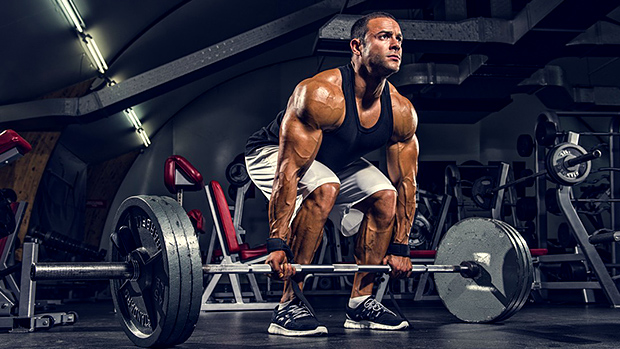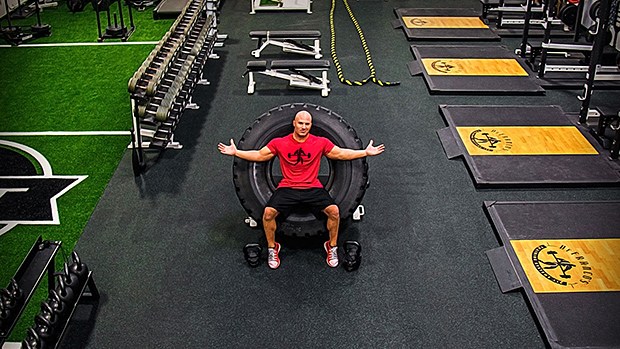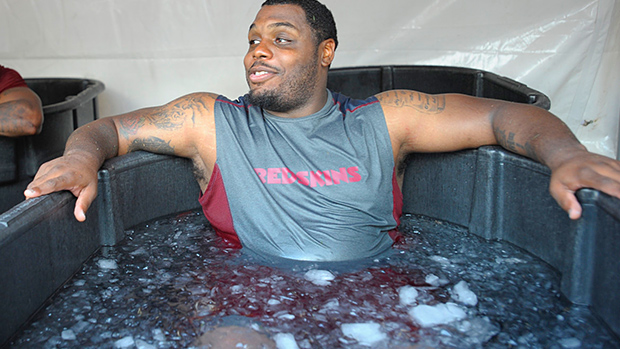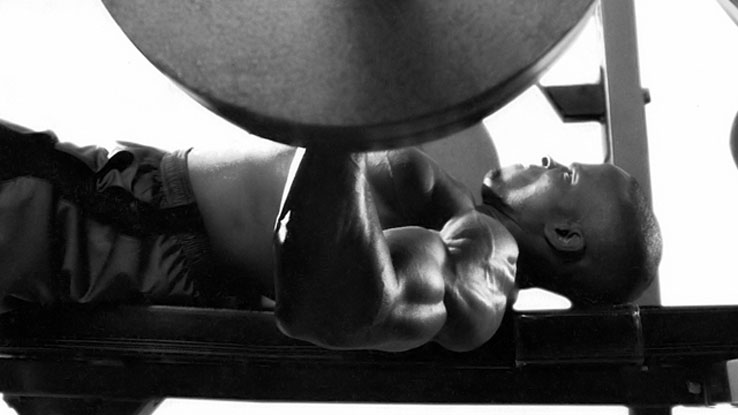Even with a fantastic exercise like the deadlift, things can go wrong and a great movement can become a dumb training tool. Avoid these mistakes:
We've all seen it. Someone struggles mightily to complete a single rep on a heavy deadlift. The lifter's eyes are almost bursting out of their sockets. You think the guy is going to pass out... and then he proceeds to do 6 MORE reps with that weight!
Here's what a bounce-and-go looks like, though we didn't want to actually hurt our exercise model, so he's using a light weight:
Bounce-and-Go Deadlift
Of course that's pretty much impossible to do without some "help" and that help comes from letting the bumper plates bounce on the floor to rebound back up. Think that's no big deal? A good bounce can give you up to 6 inches of assistance, which is substantial. The mere fact that you can do several more reps with a weight that gave you tons of trouble on the first rep from the floor should tell you something's wrong.
"Bounce and go" is the evil brother of the "touch-and-go," which is an acceptable technique. Sadly, when people say they're doing touch-and-go deadlifts, most of them let the bar bounce because they can either use more weight or crank out reps faster.
The Whiplash Effect
In order to catch a big rebound, the lifter will need the barbell to speed up on its way down. To do that he instinctively loses tightness and may even use spinal flexion instead of the hip hinge to slam the bar down.
The lower back, glutes, and hams become relaxed to let the bar fall as fast as possible. Then the bar hits the ground and bounces up. It will go up a few inches mostly using its own momentum, after which it wants to go down and that's where the muscles take over.
The prime movers are relaxed and they must suddenly contract all-out to absorb the weight and pull it up. This is a tremendous shock for the body, and it's even worse because you'll be in a bad posture most of the time. Since the glutes are harder to recruit, the lower back and hams will take the brunt of the stress. Hello, lower back injury or hamstring pull!
Detraining the Bottom Portion of the Lift
If the momentum from the rebound is what makes the barbell break off of the floor and move up those first few inches, the nervous system learns not to produce maximum tension in that portion of the range of motion. In fact, it learns to become relaxed in that position.
As a result, you'll develop a significant sticking point breaking the barbell off the floor or during the first pull. So your reps might go up, but your maximal strength on the lift won't because that first pull will always stay weak.
Positional Rewiring
You learn to deadlift from the floor using a different posture. Think about it. If you do 8 reps and use the bounce while relaxing your trunk muscles to produce a bigger rebound, you'll practice good position and technique on ONE rep (if that) and bad positions on all the other proceeding reps. Which do you think will have the greatest motor learning impact?
What will happen is that with submaximal weights you'll be able to force yourself to maintain a proper position from the floor, but as soon as the weight gets heavy you'll go to your default mode, which is whatever you practice the most.
The bounce-and-go doesn't have a place in the training for 90% of the population. The only exceptions are:
During a CrossFit Competition
Competition is the key word here because in training (yes, that means every WOD not done in a competition) you should avoid the bounce. Use the touch-and-go method. You'll go slower but the training effect will be much greater and you'll experience more potential for hypertrophy too.
As an Overload Exercise to Strengthen the Second Portion of the Deadlifts
The bounce allows you to do higher reps with a heavier weight. The first portion isn't trained that much but the second half of the pull is being overloaded.
This is a very advanced technique that should only be used by experienced lifters who have perfect technique already, and they should only do it for 1-2 weeks. Don't do it if you can't maintain perfect position and tension during the bounce. If you lose one of the two to catch a bigger rebound, skip the method altogether.
Here's how to do a proper touch-and-go deadlift:
Touch-And-Go Deadlift
- Lower the weight under control, touch the floor for one second and lift back up. It shouldn't feel significantly easier than a regular rep from the floor.
- Maintain tension and position. Hinge at the hips, do not bend the spine to get the weight to the floor. Keep the core tight (imagine getting punched in the stomach), engage the lats, and keep trying to screw your feet into the floor to activate the glutes. Go down under control; it'll make it easier to maintain tension and position. When you reach the floor on the way down, you should be in the exact position you were in at the beginning of your first rep from the floor.
- Maintain tension in the core, glutes and lats during the transition point – when you initiate the pull after lowering down the bar. If tension is lost you aren't doing it right. How do you know if you're losing tension? Either your lower back will begin to round right from the start, or the bar will move away from you slightly and you'll feel your weight shifting toward the toes.
When properly done, the touch-and-go method can be effective: you spend more time under tension (from controlling the eccentric) which will have a muscle-building effect while also making you better at maintaining a solid lifting posture under load.
Anything from 1 to 5 reps should be done with a "reset" style in training (reset on every rep after lowering the bar down) and with 6 reps or above you should use the proper touch-and-go style.
The deadlift is weird in a way. It's the one lift where smaller, less advanced people can put up big weight. You'll pretty much never see a 165-170 pound average lifter bench pressing 365 pounds, but the same guy might be able to deadlift 500 pounds. Not huge numbers, but respectable and enough to look impressive on social media.
Most of the time those lifts are achieved through sheer willpower and shitty/dangerous technique. While I respect and admire their grit, if it comes at the expense of proper form it can do more harm than good.
If you have to resort to bad form, the weight is too heavy and will be more detrimental than beneficial. Here are things that lifters do:
The Fishing Rod Technique
The whole back, upper and lower, is rounded like crazy, looking like a fishing rod when you catch a big fish.

Sure, during a maximum effort there's bound to be some technique breakdown from time to time. If you're trying to win a competition and you pull out all the stops it might be acceptable, but if you're doing it to stroke your ego on social media it isn't.
Note: Some elite lifters do pull with a rounded back. But you'll notice that the back doesn't become more rounded as they lift; it stays in pretty much the same position for most of the lift. The fishing rod refers to a drastic rounding of the back while you're lifting. That change in position is the real danger.
There's a difference between training and competing. When you train you want to improve your physical capacities, lifting technique, and resilience to injuries... which means crappy form is not acceptable, and to most seasoned lifters, it's not impressive. In competition, do whatever it takes to win (within the rules). But last I checked, Facebook and Instagram aren't competitions.
The Hitch
Basically the lifter will pull the bar normally from the floor to just above the knees. The problem arises when the bar passes the knees. That's when the lifter will wedge his knees under the bar – moving them forward while raising his torso – and then finishes the lift by extending his legs. It can almost become something like a quarter squat.
Incorrect: Hitching the Deadlift
The hitch gives the lifter a better leverage to finish off the rep. It's illegal to do in powerlifting competitions, but it's accepted in strongman. And yes, it allows you to move more weight from point A to point B, but it denatures the deadlift, which is supposed to be a way to overload the hip hinge pattern. By hitching, you pretty much take out the hinge action and turn it into a quarter squat.
Even worse is those who "multi-hitch." They do the hitching action but they lack strength to at least finish the lift smoothly and will give several tugs to the bar, moving it one inch on each tug to finally get the bar up. This is completely worthless "exercise" that is both dangerous and idiotic.
If posting a PR on social media motivates you and your 12 followers, fine. But at least show people that you know how to deadlift. Post videos of heavy deadlifts done with solid form.
No other lift is as devastating on the nervous system as the deadlift. Maxing out on the deadlift, or doing a high volume of heavy work, can negatively impact your subsequent workouts for an entire week. For that reason, training the deadlift hard every week might not be a good idea unless your nervous system is formidably resilient.
That's one of the reasons why guys at Westside Barbell rarely do a deadlift on max effort day (they mostly do squats or good morning variations). That's also why for traditional powerlifting peaking a lot of guys do their last heavy deadlift 10 days before a competition, while the last heavy squat can be done 7 days before, and the last heavy bench 5 days before the meet.
Trashing yourself on the deadlift, while satisfying, can drastically decrease your performance on your next few sessions. Remember, the key to maximum gains is how many good workouts you have. If you get two or three less solid workouts per week just to get one that's at a higher level, you won't benefit in the long run.
Why is the deadlift more demanding on the nervous system than a squat? After all, both use a similar amount of muscle mass. There are a few possible explanations and the truth is likely a combination of them:
The deadlift challenges your grip strength.
The first sign of a fatigued CNS is a drop in grip strength. So it's logical that everything that pushes your grip to its limit would also dramatically increase the neural demands of an exercise. On a side note, using straps when deadlifting does decrease the neural demands of the exercise and allow you to do more volume of heavy work or more frequency.
The deadlift provides greater axial loading.
There's more loading of the spine (axial loading), than even a low-bar squat. This is mostly true for a conventional deadlift; a sumo deadlift provides a lot less spinal loading. The spine being the key area for neural transmission, when it's "threatened" there's a much more important stress response and the nervous and hormonal systems are pushed much harder to resist to that stress.
The deadlift starts from a dead start.
Doing an exercise from a dead start instead of benefiting from a preparatory eccentric phase makes the beginning of the movement much harder. The nervous system has to activate the muscles more since you can't take advantage of the stretch reflex to get the weight moving.
Most people deadlift more weight than they can squat.
We're talking about 10-30% more in most cases. I'm talking about raw lifting, not using a squat suit and knee wraps, which help the squat a lot more than the deadlift and can give you false ratios. Of course, you lift more weight in the deadlift than in the squat because of leverage reasons, but also because more muscles are involved. More weight equals more neurological demands. It also means more stress on the skeletal and hormonal systems. All of these to make the deadlift more systemically demanding.
It's easy to have a successful deadlift with horrible technique.
In a squat, if you start to get out of the groove, you won't be able to make that lift. On a deadlift, if the bar moves forward or if you lose your lower back tightness, for example, you'll often be able to make the lift by grinding the bar up from sheer willpower. These reps are killers for the nervous system. Maxing out often like this will only hurt your training. And unless you're a world class powerlifter, nobody cares.
The deadlift is better trained with submaximal weights (75-85%) with a strong focus on using optimal technique and maintaining muscle tension and perfect position on every rep... and using assistance work to get the back, glutes, and legs stronger.
If you work on your deadlifting technique and get the involved muscles stronger via less traumatizing exercises, your deadlift will still get a lot stronger without negatively affecting the rest of your training week.
The deadlift is a hip flexion and extension exercise, also called hip hinge. It's not a trunk flexion and extension movement. There should be no trunk flexion in the deadlift. But a lot of people – especially if they have mobility issues – compensate by bending at the waist.
Incorrect: Trunk Flexion
This means that to complete the lift the spine angle will have to change during the rep, which is just about the most dangerous thing you can do while deadlifting.
Correct: Hip Flexion
If you lack the mobility to start the deadlift from the floor without having to use trunk flexion, you should reduce the range of motion by doing something like deadlifting from pins. Use the lowest pin settings where you can avoid trunk flexion. And as your mobility improves you can move down to deadlifting from the floor. Here's what the basic setup looks like:

The great powerlifter Donnie Thompson was asked by Dr. John Rusin what he would do differently if he could go back in time. Thompson said that he would do a lot less deadlifting from the floor.
Note that a lot of mobility issues are "diagnosed" as tight hamstrings. But in reality it comes from weak hamstrings, glutes, or both. The weakness creates a lack of stability and the body adapts by getting tensed to create stability. But that tension is in the wrong places, reducing range of motion. So a lack of range of motion in the deadlift will more often be solved by strengthening the glutes and hamstrings, not by stretching.
Someone with hip mobility issues could also use a sumo or squat-stance deadlift which makes it easier to avoid trunk flexion while getting a full range of motion.
I've mentioned the mixed grip before and I still think that deadlifting with it (in training) is a mistake.

It should only be used by competitive powerlifters and only in the specific or pre-competition phase. Most of the year they should deadlift with a double pronated (overhand) or hook grip. Even using straps from time to time is fine.
If you're only training to improve your appearance, gain muscle, and get stronger and you have no intention of competing, then there's nothing wrong with using straps for most of your heavy deadlift work. It's much better than using a mixed grip.
I've worked with a female powerlifter who developed a lower back and hip issue from the mixed grip, and there's also the potential it has to cause problems for your biceps.
The main issue with the mixed grip is that you'll have a natural tendency to rotate your torso/hips toward the supinated side. In other words, you'll tend to push forward with the supinated side and pull back with the pronated one.
The supinated side will also tend to stay a bit higher than the pronated side, which will more easily hang down. It'll be much easier to engage the lat on the pronated than supinated side which can make the lift unbalanced. And finally, the biceps on the supinated side will be in a much more dangerous position for a tear.
Yes, the mixed grip allows you to hold bigger weights. So if you're competing in powerlifting it'll be necessary to use in competition. And if you use it in competition, you'll need to practice it because it feels different than a double pronated grip.
But even for competitors, the double pronated grip is a better option for most of your training. It's safer and will make your grip stronger. If grip is an issue, you can learn to use the hook grip, which is as strong as the mixed grip once you get comfortable with it:


Use the mixed grip only on the last 4 weeks prior to your competition, and ideally, switch arms every set to avoid creating an imbalance.





